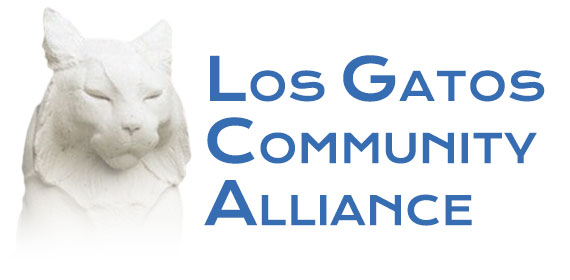March 14, 2024 Joel Paulson
Community Development Director
Town of Los Gatos
110 E. Main Street
Los Gatos, CA 95030
Re: March revised draft of Los Gatos 2023-2031 Housing Element
Executive Summary
Program J in Los Gatos aims to increase housing options by allowing more multi-unit dwellings. However, the LCGA argues the program lacks proper feasibility analysis.
- The Town hasn’t assessed if Program J’s goals are achievable, particularly regarding affordability for low and moderate-income residents.
- A San Jose study on similar housing types suggests such development is financially infeasible in areas with high land costs, like Los Gatos.
- This raises concerns Program J may worsen housing inequity by creating more expensive units only accessible to high-income earners.
The LCGA proposes a more targeted approach:
- Identify areas near transit with high redevelopment feasibility.
- Create a new land-use category encouraging multi-family development with densities of 6-13 units per acre.
- Focus on achieving housing equity by prioritizing affordability for those most in need.
Dear Mr. Paulson,
The Los Gatos Community Alliance (LGCA) is a group of concerned residents writing to you regarding the March 2024 revised draft of the 2023-2031 Housing Element. We respectfully offer the following comment regarding Program J, which is attached (Attachment 1).
Program J
Program J was created in response to HCD’s concerns regarding the adequacy of the Town’s goals to address affirmatively furthering fair housing (AFFH). HCD requested that actions furthering AFFH and enhancing housing mobility (e.g., choices and affordability) be added to the Housing Element to better promote inclusive neighborhoods throughout the Town. HCD pointed out that this was particularly important because the Town is wholly a racially concentrated area of affluence, highest resource, and highest median incomes in contrast to the rest of the region. We understand HCD’s concerns regarding AFFH and agree with the goal to enhance housing mobility by providing increased choices and affordability. While there is no disagreement with the goal (the what), LCGA does have concerns as to how to achieve the goal (the how).
The objective of Program J is to increase the number of housing units in a variety of neighborhoods by modifying the zoning code to facilitate the development of ADUs, JADUs, and small multi-family units such as duplexes, triplexes and fourplexes, to name a few. Success in Los Gatos will be measured by the Town’s ability to facilitate over the next eight years the development of 150 units including the combination of ADUs, JADUs and small multi-unit housing, including 30 of these units being affordable for low and very-low-income groups, in low to medium density designations and high-median income areas.
Program J replicated policies LU 1.1 and LU 1.2 from the 2040 General Plan Land Use Element. The Land Use Element is subject to a referendum and has been suspended until the referendum is resolved. The legal implication of including LU 1.1 and LU 1.2 into the Housing Element while the Land Use Element is in dispute is unclear and the Town should consider this.
More importantly, while Program J may appear on its face to be a reasonable concept, the Town has not analyzed the feasibility of the program to determine whether the stated goals can be achieved in the specified manner. In assessing feasibility, it is critical to determine whether the “financially feasible”
outcomes are attainable at area median income levels and not just the highest median income levels. Unless the additional housing units delivered by Program J are truly attainable by most of the population, the Program is unlikely to achieve its equity goals. This is the heart of what the Housing Element is addressing.
That is why the LGCA is writing to you today; to bring to your attention the fact the Town has not done a needed feasibility analysis to be reasonably assured Program J will deliver the desired outcomes.
Background
In 2021 the City of San Jose commissioned the consulting firms Strategic Economics and Opticos Design to evaluate the feasibility of 2-4-unit housing development projects on parcels within one-half mile of transit-oriented locations. The City also evaluated the potential for 2-4 multi-family units citywide due to equity concerns.
The locations were envisioned as walkable, bikeable, and transit-rich neighborhoods while generally maintaining zoning setbacks and heights. The report included an evaluation with a site design lens the extent to which certain Missing Middle housing types, such as a stacked fourplex, could be built in residential neighborhoods.
To evaluate the feasibility of 2-4-unit housing development across the City of San Jose, Strategic Economics mapped the housing market for ownership and rental housing in 12 San Jose sub-areas. Each sub-area was further categorized into a market tier. This allowed for the study to reflect the fact that different areas of the city have different land values, sales prices, and rents, all of which affect the likelihood of 2-4-unit housing development projects being built.
Three tiers were established based on the strength of the housing prices and rents. Tier 1 represented the highest value market tier, while Tier 3 was the lowest. Tier 1 included sub-areas West Valley, Willow Glen, Central and North. Tier 1 would be the closest to Los Gatos in terms of relative strength of housing prices and rents, with most of Los Gatos having substantially higher land values, sales prices and rents.
Results
The study focused on four units in one house-form as the optimal building type to evaluate. This form is called a “stacked fourplex” and consists of two units on the ground floor and two units stacked directly above. This form was chosen because significant parts of San Jose could accommodate the required lot size of lots with 50-to-60-foot widths and 125 feet deep. A typical unit was 1,080 square feet with 1.25 parking spaces per unit. The development density was approximately 23 DU/acre. A stacked fourplex was determined to be a logical baseline building type for analysis.
The 2040 Land Use Element, Figure 3-5 (Attachment 2) illustrates how on a typical block a 2-4-unit housing could be developed in Town. A stacked fourplex is shown as one of the housing forms. It provides four units, but within an overall footprint that is comparable to single-family homes. Therefore, a stacked fourplex was an ideal housing type to deliver attainability due to smaller unit sizes and due to its massing and orientation that works well in single-family neighborhoods.
However, the financial feasibility analysis concluded that this type of unit was financially infeasible for both rental and for-sale products. As a result, this type of unit was unlikely to contribute to additional housing of the desired types in San Jose.
We have attached (Attachment 3) the resulting financial model. Because of the high land acquisition cost of the redevelopment site, the residual land value less the typical acquisition cost is negative for all tiers and for both rental and for-sale products. Normalizing for property values in Los Gatos, the negative residual land costs would even be larger.
Conclusion
The San Jose study strongly indicates that Program J will not deliver the desired objectives for 2-4-unit development projects Town wide. Program J would not create housing attainable by many residents, further increasing housing inequity, and no affordable units for low and very low-income groups would be developed. The solution proposed by Program J fails to address the feasibility of redevelopment that makes the problem challenging in the first place. The current program, with the intent to broadly expand multi-family units and promote housing equity Town wide, would in fact fail to achieve these goals. Instead it is likely to result in the production of more (and denser) market-rate housing attainable by only the highest income groups.
A more thoughtful approach would be to identify appropriate areas within one-half mile of transit points, which are walkable, bikeable, and near services, and which have the highest feasibility of redevelopment. Once identified, the Town should create a new low-medium density residential land use to encourage multi-family development with density ranges between 6 and 13 units per acre. LGCA has long advocated for policies that will deliver affordable housing to those in most need as opposed to policies that will result in more (and denser) market-rate housing attainable by only the highest income groups and ultimately exacerbating housing inequity.
Los Gatos Community Alliance

